Título :
The extended role of carrion: Insect consumption and hair taking at fox carcasses |
Autor :
Redondo-Gómez, Daniel
Gil-Sánchez, José M.
Gonzálvez, Moisés
Martínez-Carrasco, Carlos
Sebastián-González, Esther
Rosell, Lidia
Jiménez-Nájar, Pablo
Sánchez-Zapata, José A.
Martín-Vega, Daniel
Moleón, Marcos |
Editor :
Elsevier |
Departamento:
Departamentos de la UMH::Biología Aplicada |
Fecha de publicación:
2025-03 |
URI :
https://hdl.handle.net/11000/37980 |
Resumen :
Scavenging has been profusely studied in the last decades. However, carrion is more than a direct source of food for scavengers and decomposers, as it may provide many non-scavenging ecological functions. These include the provision of carrion insects to insectivores and hair to nest-building species. However, the patterns of use of these resources are greatly unknown. In this context, carnivore carcasses may represent an outstanding study model because they usually persist in the environment for longer than herbivore carcasses. Here, we used videotrapping to explore the consumption of carrion insects and hair taking at 99 red fox (Vulpes vulpes) carcasses in three areas of southeastern Spain. Carcasses were frequently used for consuming insects and taking hair (7.3 events in total on average per carcass). These non-scavenging behaviors were observed over eight weeks for most carcasses, peaking around the fifth week. Birds were the main users of carcasses, distantly followed by mammals; reptiles were only recorded feeding occasionally on carrion insects. These behaviors were more frequent during spring, when the demand for insects for offspring feeding and hair for nest building is maximized by many vertebrates. Moreover, the community of species exhibiting each of these behaviors was highly organized, as evidenced from their nested structure. We observed co-occurrence of insect consumption and hair taking in a quarter of carcasses, with co-occurrence being mostly due to chance and certain individuals and groups that used some carcasses for both purposes. Overall, non-scavenging uses of fox carcasses by vertebrates in our study area is more frequent than scavenging, which highlights the broad ecological relevance of carnivore carcasses and opens exciting future research avenues.
|
Palabras clave/Materias:
Carnivore carcasses
Larvae
Necrokleptotrichy
Nest building
Non-scavenging functions
Non-trophic functions |
Área de conocimiento :
CDU: Ciencias puras y naturales: Generalidades sobre las ciencias puras: Ciencias del medio ambiente |
Tipo de documento :
info:eu-repo/semantics/article |
Derechos de acceso:
info:eu-repo/semantics/openAccess
Attribution-NonCommercial-NoDerivatives 4.0 Internacional |
DOI :
https://doi.org/10.1016/j.baae.2024.12.008 |
Publicado en:
Basic and Applied Ecology 83 (2025) 12–22 |
Aparece en las colecciones:
Artículos - Biología Aplicada
|

 La licencia se describe como: Atribución-NonComercial-NoDerivada 4.0 Internacional.
La licencia se describe como: Atribución-NonComercial-NoDerivada 4.0 Internacional.
.png)